Why Does He Say Family Is So Important?
How 'family unit' is being redefined for the modern globe
(Image credit:
Gigi Kaeser / Love Makes a Family
)
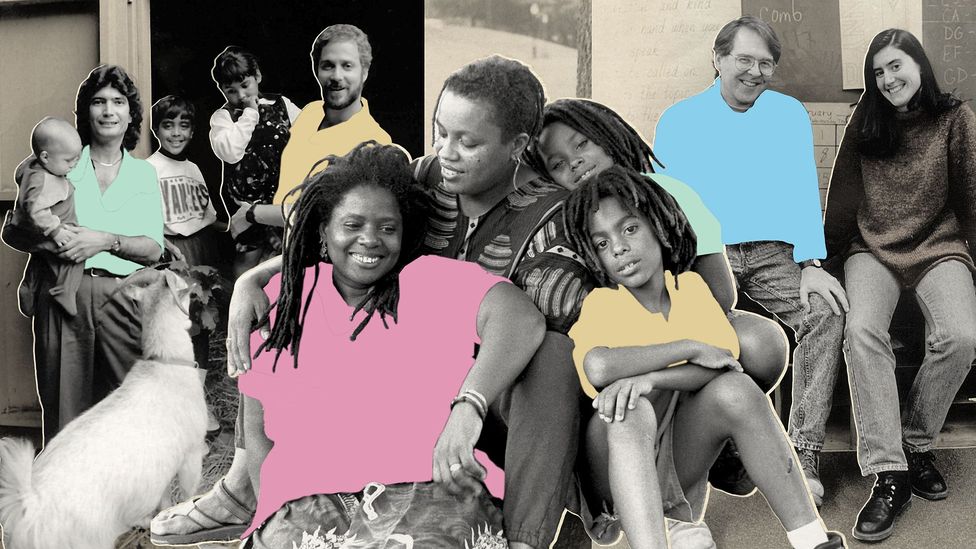
Families that were once seen as groundbreaking, experimental or taboo are speaking upward, and irresolute how nosotros think about parenting.
Yard
Gee Roberts, a 23-twelvemonth-onetime medical student in Exeter, England, is planning her wedding. Her mum and dad will be there, of grade, and another important guest: Suzanne, her surrogate, the adult female who gave nascence to her in 1998.
"She's a actually of import person in my life, and she'southward a really of import office of my family," says Roberts, who was ane of the offset few hundred babies to be built-in via modern surrogacy in the Uk. When outsiders are confused about her parentage, she draws them a piddling family tree. To her, it's simple: "[There'southward] my mum, and then I've got my surrogate, and they're different people."
Surrogacy, which involves a woman carrying a child for another person or couple, is banned in its commercial grade in Britain, only allowed as a non-turn a profit arrangement. According to the organization that facilitated Roberts' surrogacy, need now far outstrips the number of willing surrogates. Information also shows the number of people using fertility treatments with surrogates has jumped by as much every bit 22% in a year. Some, like Roberts' parents, come to it after struggling with infertility. For others, such equally gay couples, information technology is 1 of the few routes to parenthood, aslope adoption.
Similar every new family grade that emerged in contempo decades, surrogacy has caused much controversy – including over the potential psychological impact on the children born of it. That discomfort around new types of family is partly linked to a sense of uncertainty. Whether created with the assistance of new technologies or thanks to social change, these families often face up the accusation that they are risking the wellbeing of future generations. After all, if no 1 has ever conceived or raised a child this way before, then how tin we possibly predict the consequences?
In reality, we know far more virtually new family unit forms than is often causeless. For a start, many once-pioneering families at present span several generations, and take vital lessons to share. In addition, while each family is different, researchers have uncovered certain patterns which announced to apply to all families – including, mayhap, ones currently unknown.
As a result, we have a surprisingly detailed picture show of families that were once seen as niche, merely that are going to define the 21st Century. Later on all, unconventional parenthood is on the rising. Same-sex couples make up an increasingly large share of adoptive parents, and the use of donor eggs and sperm is increasing as older couples and single people cull parenthood, to proper noun just two growing trends. Equally diverse every bit these families are, many grapple with similar questions, such equally how to tell the children nigh their origin, or how to best manage relationships with third parties, be they surrogates or donors. Thanks to decades of research, many of those questions tin can now be answered.
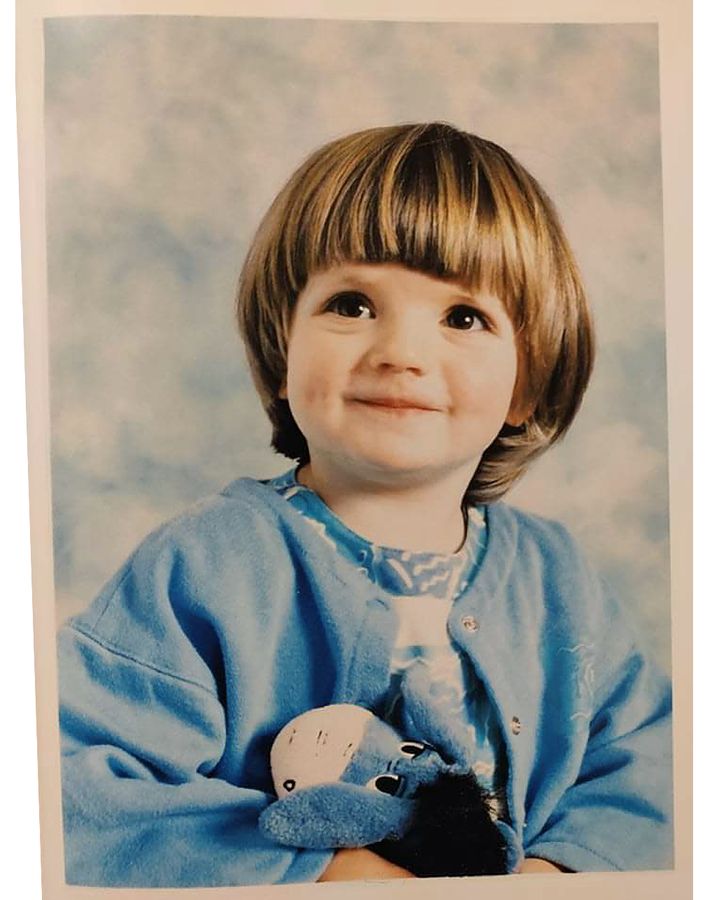
"I have always been where I was meant to be. I was meant to be the child of my parents, and that's where I am," says Gee Roberts, born via surrogacy in 1998 (Credit: Gee Roberts)
"It's very ingrained in our lodge that the traditional family is the best environment for raising children," says Susan Golombok, a psychologist and erstwhile director of the Centre for Family Research at the Academy of Cambridge. She is the writer of a book on new family unit forms, called We Are Family unit: What Really Matters for Parents and Children.
Golombok'south research began in the 1970s, with a study of lesbian mothers and their children. At the fourth dimension, lesbian mothers routinely lost custody of their children, even in cases where welfare workers gave glowing reports of their parenting, considering the courts ruled that their same-sex relationships would crusade the children mental and emotional harm. In fact, when Golombok began her work, no openly lesbian female parent had always been granted custody of her children by a United kingdom of great britain and northern ireland court. Some mothers were even ordered to sleep autonomously from their female partners whenever the children visited.
Later, Golombok and her colleagues researched gay fathers, trans parents and their children, families with children conceived via egg or sperm donation, or surrogacy. What they establish, disproved "the assumptions that people had made nigh the impact on children of families that don't fit the traditional nuclear model".
In study afterward study, good relationships between parent and child, with warm, responsive parenting, and open up communication, were shown to be more important for the children's wellbeing than the gender, sexual orientation, number and genetic relatedness of the parents, and the style the children are conceived – all once thought to exist major factors in their emotional and psychological development. The research, together with campaigns from the families themselves, transformed custody cases and led to landmark legal change, such as the UK's decision in 2002 (later on in Scotland, in 2007) to allow same-sex couples jointly adopt.
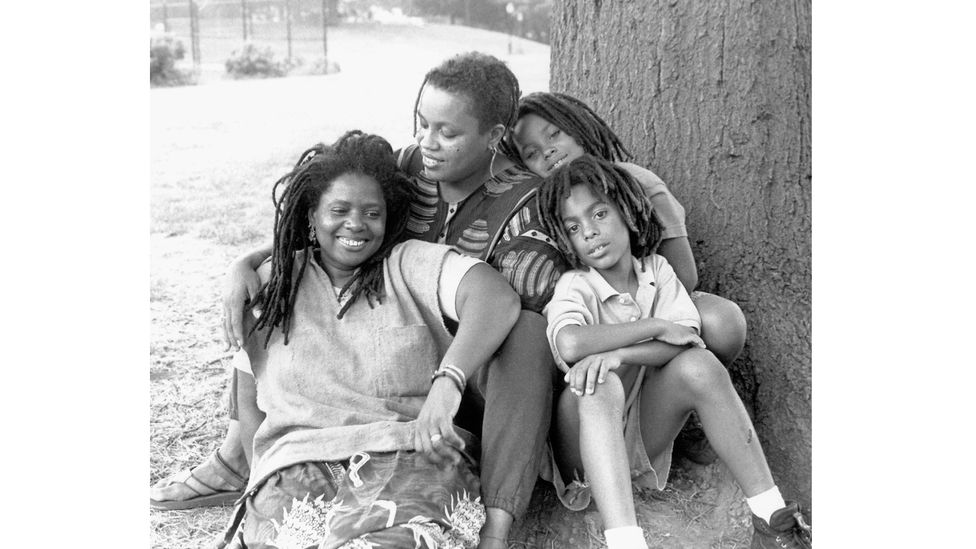
The Stokes-DuPree family in the 1990s. "The common thread is dearest," says Nabowire DeVore-Stokes, pictured here as a child at the back (Credit: Gigi Kaeser / Love Makes a Family)
"Nosotros've now had huge amounts of research on all dissimilar kinds of new family unit forms that have come up to the same conclusion, that what really matters for children is the quality of family unit relationships, as opposed to the limerick of their family," says Golombok.
Golombok expects this to be the instance in still-novel family forms, such as those with children created with the eggs and sperm of 3 people, or at some distant indicate, with eggs and sperm derived from human stalk cells. The way the eggs and sperm are obtained, or the number of genetic parents, probably won't matter that much for the children'due south wellbeing, in her view.
However, researchers did find a persistent threat to new family forms, i that can harm the mental health of children: social prejudice.
A dad'due south story: "Living a lie"
"When my dad came out when I was in centre schoolhouse, I did not know any other families who had openly gay parents," Dana Arnaboldi says, remembering her babyhood in Massachusetts in the 1980s. "Then a challenge for me was feeling a fleck isolated or nervous about people's reactions."
Her father, Allan Arnaboldi, recalls feeling fearful. His ex-wife, Dana's mother, was accepting. But club was non. He worried that coming out as a gay father might go him fired from his job as a principal school teacher, brand information technology difficult to find or keep housing, and hurt Dana'southward social life and friendships.
"I likewise did not know any other gay fathers for a while, so I was in conflict about not being like straight fathers or feeling different from other gay men who were not fathers; that was kind of like living a lie within each grouping or keeping ourselves separate," he writes in an e-mail.

A 1990s exhibition titled Dear Makes a Family increased sensation of new families, such as Allan Arnaboldi and his daughter, Dana (Credit: Gigi Kaeser / Beloved Makes a Family unit)
Somewhen, Allan and Dana Arnaboldi took part in a photograph exhibition on diverse families in the 1990s, called Dear Makes a Family: Portraits of LGBTQ People and their Families. When the exhibition came to the school where he taught, a modest number of families protested. Only there was also an outflowing of support.
"I recall information technology also helped some other gay and lesbian teachers in the schoolhouse organization to come up out and for gay parents of some of my students to speak with me more comfortably," he says.
That sense of parenting confronting the odds is typical of new family forms, researchers say.
"When the whole culture is telling you that you can't perhaps do a practiced chore at this, that's a pretty heavy message," says Nanette Gartrell, a psychiatrist and chief investigator at the National Longitudinal Lesbian Family Study in the Usa.
In the 1980s, Gartrell and her colleagues began studying a group of lesbian mothers who conceived children via sperm donation.
At the time, information technology was believed that "these parents could non possibly create a healthy surround for these children, that the children would be psychologically damaged". Some had been rejected past their own parents for deciding to have children. 36 years on, near all of them and their children are still part of the long-term report.

Activists march in support of lesbian mothers' custody rights in a Pride Parade in New York City in 1975 (Credit: Peter Keegan/Keystone/Hulton Archive/Getty Images)
Gartrell and her team establish that social stigma shaped the mothers' experiences, but also, that they managed to buffer the affect on the children'south mental wellness.
"They had a want to show the world that they could be adept parents, and that their children could do well," she says. "It took a tremendous amount of work to deal with the homophobia and stereotypes that they encountered at every phase of their kid's growth and evolution."
When the children were 10 years quondam, they scored as well or amend than their peers on standardised tests measuring their psychological wellbeing. However, 43% had experienced homophobia for having lesbian mothers. They had higher levels of anxiety and depression than the remainder. Yet the study also identified protective factors. Children who attended schools that included LGBTQ+ issues in the curriculum, and whose mothers were active in the lesbian community, fared better than the others in terms of their mental wellness. Talking to the children about ways to respond to negative comments, was also institute to be benign.
At the age of 17, the adolescents had skillful mental wellness, were academically successful, enjoyed close friendships and family bonds, and rated their happiness highly. However, one-half the children again reported having experienced hostility for having lesbian mothers, which injure their mental health. Nevertheless, having shut relationships with their mothers cancelled that negative impact.
Gartrell believes these families' solutions, such as finding peer back up, and rehearsing responses to negative comments, would be useful for whatsoever child being marginalised, whatever the reason.
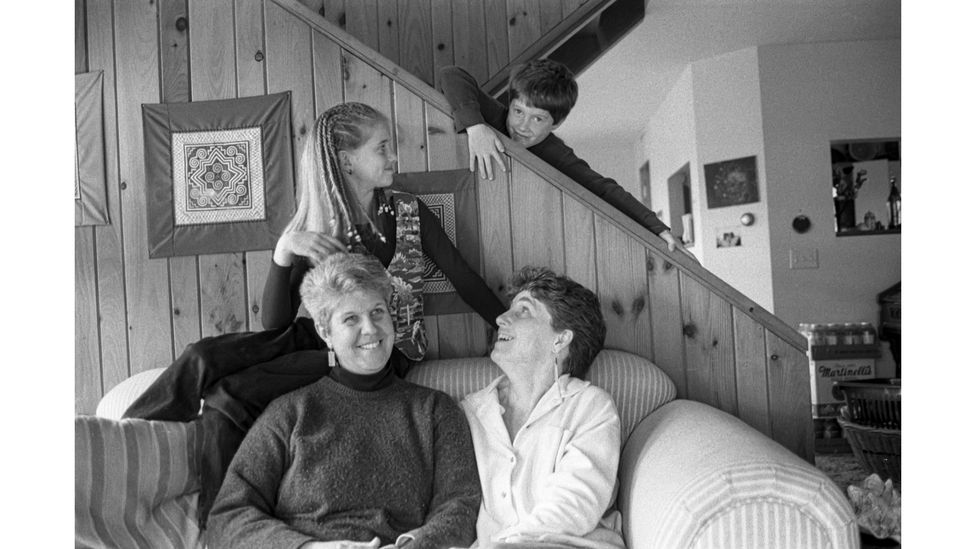
Robin Jurs, Barbara Allen and their two children, Hannah and Cody, in the 1990s (Credit: Gigi Kaeser / Love Makes a Family)
Into the open: "The mutual thread is love"
"We sought out a place to raise our children that would be inclusive and welcoming of 2 women raising children," says Robin Jurs. She and her partner, Barbara Allen, raised their 2 children in Northampton, Massachusetts, in the 1980s and 1990s. Their strategies were similar to those used by the women in the report: finding a friendly surroundings, and helping their children when they faced negativity.
"There was the time some other kid told our daughter that she did not have a 'real family unit' because she did not have a dad," Jurs recalls. They talked to the instructor, who decided to hold a lesson in which the students would interview different families, including theirs. "We were able to naturally accost being a family unit without a dad while pointing out to the students that there are many forms of family."
Barbara Allen remembers the ordinary joy of family life. "When the kids were growing upward, I felt grateful that I was spending a Friday night folding trivial socks," she writes in an e-mail. "I was proud that my shopping cart was full of their favourite foods, I loved giving and getting hugs, and at times I was simply the chauffeur. And of course, as with any family, much much more than."
Nabowire DeVore-Stokes, a dance creative person who was featured in the Love Makes a Family exhibition as a child, echoes that sentiment. Looking at the photo of her family, she feels that "information technology's keen that it tin be an example of what families expect like. Our family dynamic is different now but at that place are many people that shape our family unit and the common thread is love, which I call back is ane thing that has stayed constant before and now in our family."
When asked to look back on 25 years of parenting, the mothers in the longitudinal study said that ane of their best moments was seeing their children capeesh diversity. Equally Gartrell concludes: "Their kids were incredibly proud to be raised by mothers whom they saw as leaders, in this first generation of lesbian-parent families."
Golombok and her team establish a similar blueprint across other new family forms, of parents trying hard to support their children. Gay fathers of adopted children, for example, showed more parental warmth and were more responsive to their children, than heterosexual adoptive parents.
Along the way, many families redefined what information technology means to be traditional.
"Rob and I were ane of the outset gay couples to prefer kids in the Us. Although that'south fairly routine nowadays, as are alternative paths to gay parenthood like surrogacy and IVF, four decades ago information technology was pretty groundbreaking," writes Jon Cooper in an e-mail.
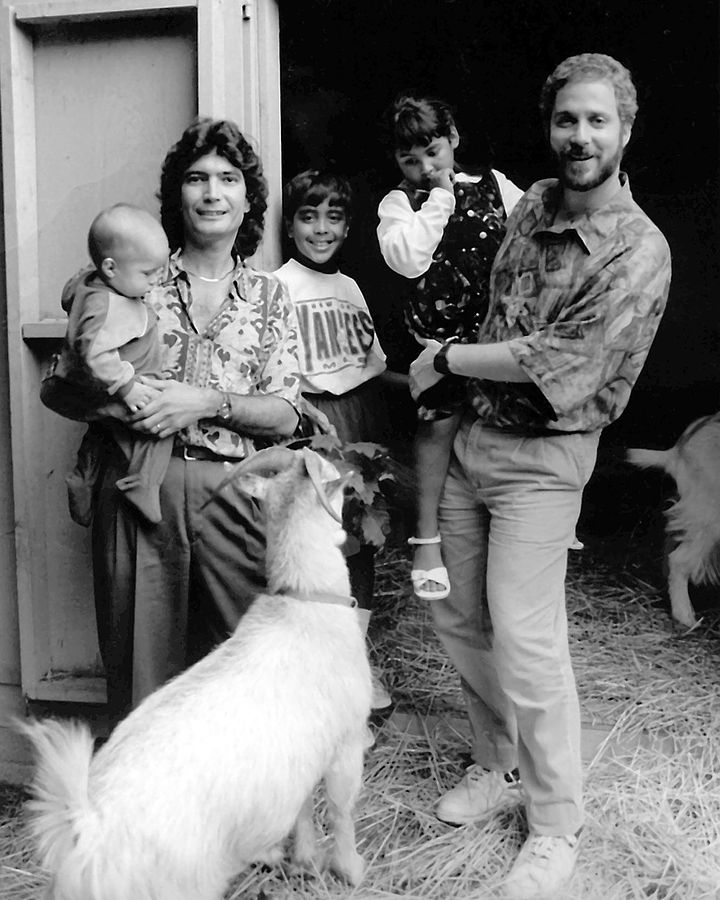
Rob and Jon Cooper with baby Christopher, Daniel and Jessica. They afterward adopted two more children, Jennifer and Kimberly (Credit: Gigi Kaeser / Beloved Makes a Family)
The Coopers adopted five children, all of whom are now adults. 1 of them is getting married later this year. "Luckily, we raised our growing family in a progressive town on Long Island with a very welcoming local community. Nosotros encountered only positive reactions from our neighbours," Jon Cooper recalls.
Their family form has now become much more mainstream. In the US, 24% of female same-sexual activity couples, and 8% of male same-sexual activity couples, are raising children. In the U.k., about 17% of adoptions are at present past same-sex couples.
And yet, sometime prejudices continue to re-erupt. In the UK in the 1980s, a children's book about a little girl raised past her dad and his male partner, called Jenny Lives with Eric and Martin, caused a public outcry and led to a law that effectively stopped schools from mentioning same-sex relationships. The constabulary has since been repealed. But equally recently every bit 2019, a children'southward book featuring two male penguins raising a chick, prompted groups of parents to besiege British master schools, once again demanding that same-sexual practice relationships not be mentioned at all.
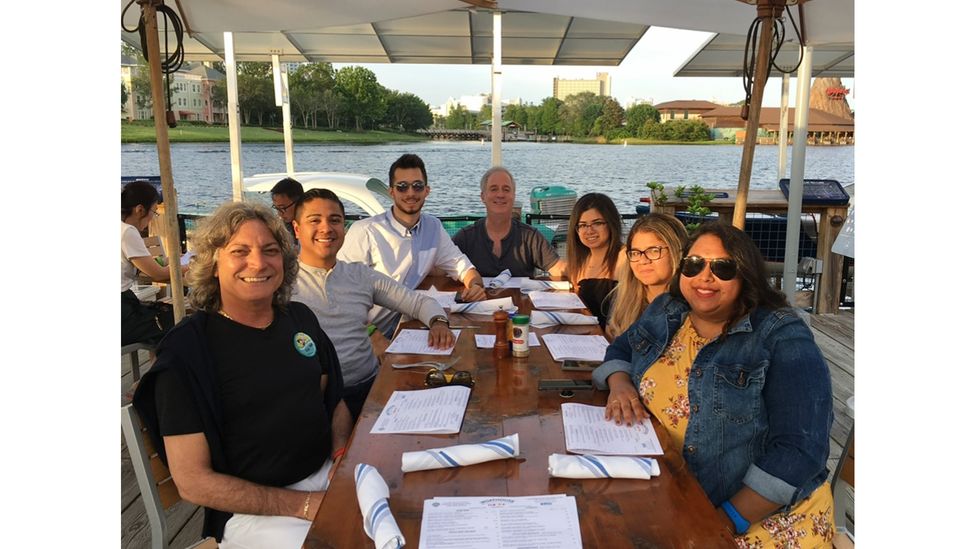
Rob and Jon Cooper, and their grown children. Christopher, who was a babe in the Love Makes a Family unit photo, is getting married after this yr (Credit: Jon Cooper)
For Dana Arnaboldi, changing attitudes and laws take transformed her experience: "When I was in high school and my dad had recently come out, not many of my friends knew he was gay. It would never occur to me now to hide that fact from anyone." She at present has ii children, who "are growing up around all kinds of families, and I don't think they have whatever expectations about what a family 'should' look like".
The offset wedding her daughter attended as a baby was that of her grandad, Allan, to his partner Mitch, in 2006, 3 years after Massachusetts legalised aforementioned-sexual activity wedlock.
Allan Arnaboldi says one of his granddaughters had an feel with a friend that reminded him how far the world had come. The friend, a girl, said she was transgender. When the granddaughter asked what that meant, the friend said she was born a male child only felt that she was really a girl, and therefore lived as a girl. "Our granddaughter was nonplussed and continued conversing about something totally unrelated every bit if it was just a new scrap of information, just no reason to reject this girl'south friendship," he says.
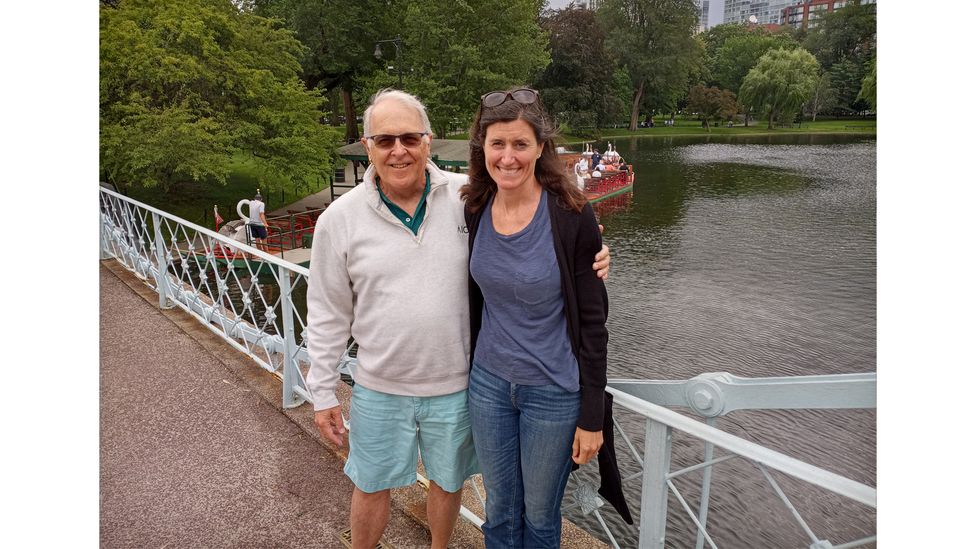
Allan Arnaboldi and his daughter, Dana, in 2021 (Credit: Allan Arnaboldi)
Information technology was not just gay and lesbian parents who were encouraged to live a lie. Mothers and fathers who conceived with the help of a sperm donor, due to the husband's infertility, were also advised to hide that fact – even from their own children. It was thought that this would avoid confusing them.
The upshot, however, was at times disastrous. Some children sensed that in that location was a secret. Others eventually found out by accident. In recent years, outraged donor-conceived people have been pushing for the right to know near their heritage, and thereby access vital information such every bit their medical history, and number of half-siblings.
At present, the advice is the opposite: openness.
"What we found from our research is that the earlier parents begin to talk to their children most their origin, where they came from, how they were conceived, the better," says Golombok. Some parents in her squad's study started in babyhood, with books and stories, and later answered questions as they arose. The children were sometimes curious, but not dislocated or upset. "The children who are distressed about information technology are those who detect out subsequently on, equally teenagers or as adults."
In the Great britain, the law was changed then that if a person donated sperm, eggs or embryos later on April 2005, people conceived from the donation have the right to find out their donor's identity at the age of eighteen. That starting time cohort of full-disclosure, no-anonymity children is about to come up of age, and whether they will exercise that right or not, information technology marks a new chapter.
Gee Roberts has always known about her origins. Throughout her babyhood, her parents arranged meet-ups with Suzanne, her surrogate. They explained that she was her "tum mum", who carried her in her tummy. Roberts doesn't apply that term herself at present, since she doesn't see Suzanne as her female parent, but the explanation with the breadbasket made sense to her.
In primary school, when asked to depict a picture of her mum and dad, she added in Suzanne, likewise. At the aforementioned time, she has always felt secure about her ain place in the family unit, and the fact that her parents are the people who raised her.
"I have ever been where I was meant to be. I was meant to be the kid of my parents, and that's where I am," she says. "I was born because my parents wanted me."
In 2019, Roberts visited the United Nations in Geneva equally role of a entrada to protect the rights of donor-conceived and surrogacy-born people, and gave a speech about her family'southward positive experience with surrogacy. She was struck by the pain and trauma of donor-conceived people who were lied to, and the dissimilarity to her ain community of surrogacy-built-in children, who tend to know how they came into the world.
"It's much harder for parents to pretend it hasn't happened," she says of surrogacy. "And I think that means people have to be open from the offset."
This honesty, Roberts believes, has had large emotional benefits: "People born through surrogacy, they're not lied to, they don't experience betrayed past their parents, or that anyone'south been deceitful. They just go on with their lives, because that's how they were born, and information technology's fine."
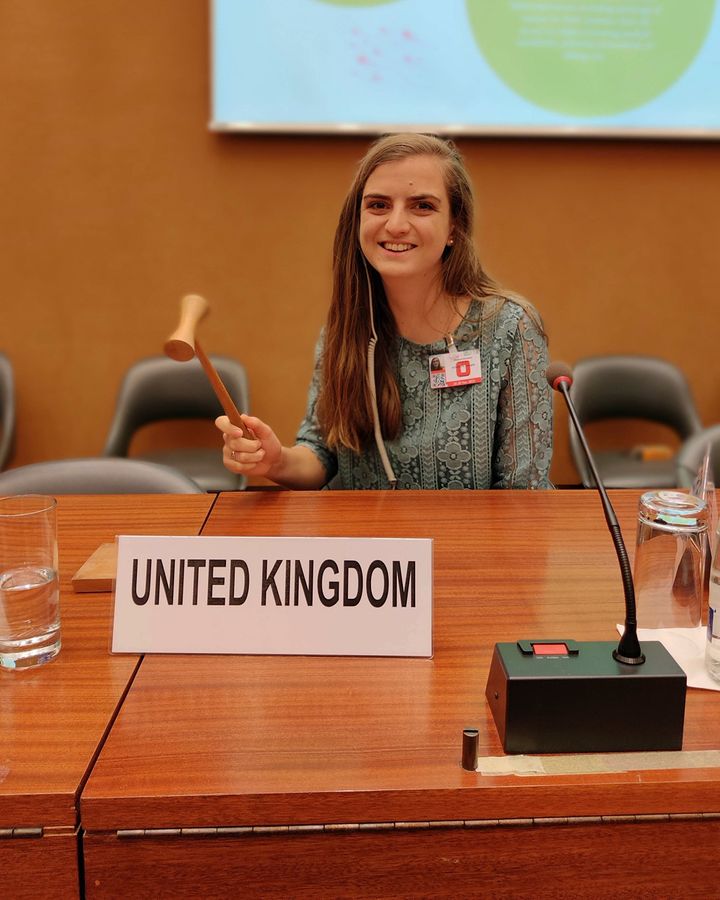
Gee Roberts, who was born via surrogacy, gave a speech about her positive experience at the Un in Geneva in 2019 (Credit: Gee Roberts)
Research on surrogacy-born children is still limited, just what has been carried out and so far backs the idea of a generation accepting of their origins, at to the lowest degree in the UK and U.s.a.. In United kingdom of great britain and northern ireland surrogacy families, the children had positive relationships with their mothers, and felt skillful virtually their surrogate and their nascency. In most cases, the families and the surrogate stayed in touch over fourth dimension, and the surrogates generally fared well. A written report of gay fathers in the US institute that the dads talked to their children about their origins early on, and had a good relationship with the surrogate. The children had proficient relationships with their parents, and high levels of psychological wellbeing.
However, at that place take besides been cases of traumatic surrogacies.
A tale of two surrogacies
Kim Cotton wool, now a grandmother of vii living in a village nigh Cambridge, was the UK's outset surrogate. She already had 2 children of her own when she agreed to deport a baby for a couple living abroad, conceived via artificial insemination. She never met the intended parents. "It was done anonymously," she says. "And that to me, now, is quite abhorrent, really. That'south my regret, the only regret I really take."
She gave birth to the baby girl in a London hospital on a cold January day in 1985. News of the surrogacy threw the country into a frenzy. Cotton fiber had to be smuggled out of the hospital, hiding on the floor of a car, with a blanket thrown over her, to escape the trounce of reporters. Journalists defendant her of renting out her womb and selling her child. A ban on commercial surrogacy was rushed through.
She never saw Baby Cotton, equally she however calls her, once more.
"I didn't dare cuddle her too long in the hospital, considering she looked like one of mine," she recalls, her voice tinged with sadness. "Information technology was very difficult, really."
Her story has a twist, all the same. Cotton went on to plant a non-profit surrogacy organization, called COTS (Childlessness Overcome Through Surrogacy), in the promise of supporting others. A few years later, she became a surrogate once again, with twins, via IVF.
This time, information technology was for friends, and she and the intended mother attended scans together. The parents were in that location at the birth: "The joy in the delivery room… it was fabulous." To this day, they remain in impact. Cotton describes her relationship with the twins equally aunty-similar: "They are not genetically mine, but there is a bond." She wishes she could accept congenital such a human relationship with Infant Cotton, likewise.
In the U.k., an endeavour is underway to reform the law and create a clear process for surrogacy. Just in some other countries, where surrogacy was previously unregulated, the police has been tightened.
Nishtha Lamba, a senior lecturer in psychology at Middlesex University Dubai, studied the psychological welfare of Indian surrogates, at a fourth dimension when India was a hub for international surrogacy. The women named fiscal necessity as their principal motivation. Just, in a striking parallel to Cotton wool's experience, they nevertheless hoped for at least a basic relationship with the families they helped create around the world.
"All of them wanted to meet the intending parents," Lamba says. They wanted to know the baby was going to a good domicile. However, near half of the women Lamba interviewed never met the intended parents at all: not before, during or afterward the birth. Over 70% of them never fifty-fifty met the child, who was taken away straight afterward nativity.
"I wanted to see the baby just one time equally I would never get this moment again in life," one of them told Lamba. "I just saw the hands and legs of the baby."
When Lamba interviewed them, months afterwards the nascency, some were all the same hoping that the parents would make it bear on.
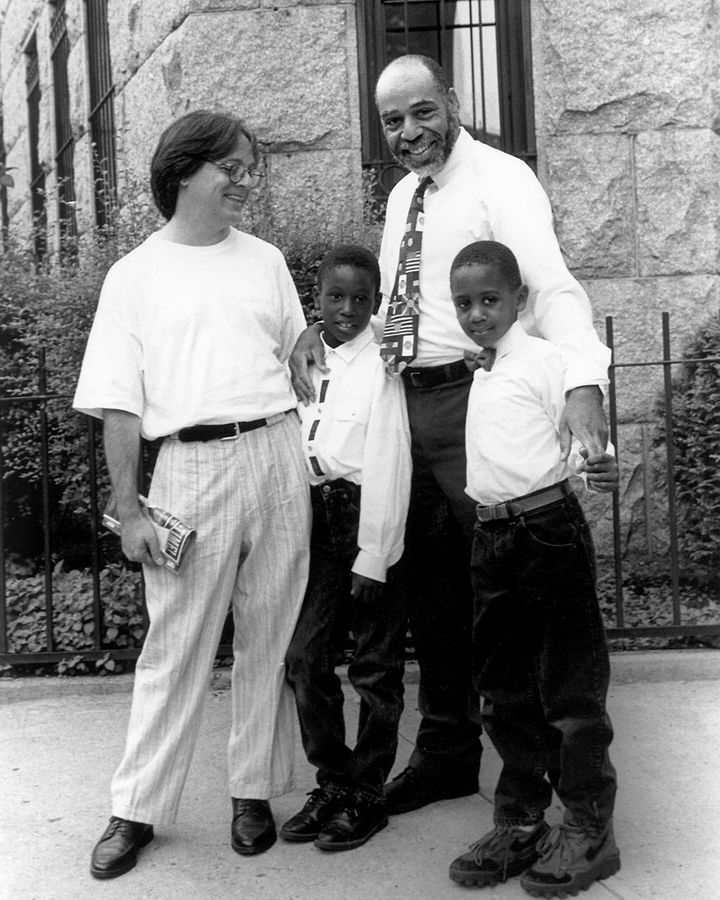
Michael Elsasser, Doug Robinson and their sons, Zachary and Justin, in the 1990s. The family has grown, as Zachary now has 2 children (Credit: Gigi Kaeser / Love Makes a Family unit)
Family Tree
Beyond "the traditional way"
New family forms can enhance complex questions about the relationships that define us. Simply even in the by, society learned to adapt to such change. In fact, the family has always been fluid, much more than and then than is often assumed, co-ordinate to a study on the history of diverse families past Patricia Thane, a visiting professor in history at Birkbeck College in London.
For a start, people died younger, and men died younger than women, leaving many widows to raise their children lonely. "There were as many single-female parent families in the later on 19th Century, every bit at that place were in the afterward 20th Century," she says. Older people in the past might take no surviving children, or the children might accept moved away to find piece of work, and it was harder to go on in affect. Now, technology makes information technology much easier for generations to maintain contact over a lifetime.
As our ain society's idea of family unit continues to evolve, those with an unusual origin story may find surprising advantages. Gee Roberts, for example, sees it as an asset as she deals with people from all walks of life in her medical career: "Then many families now are not just made up of a mum and a dad, in the traditional fashion. And I'chiliad probably someone that people can be quite open up with about that."
In one case, when she was working in a hospital, she overheard a nervous word among the staff. A child had been born via surrogacy. The 2 dads were waiting to take the babe habitation. At that place was some dubiety over how to proceed.
Roberts went to see the fathers, and, like an envoy from the future, handled the situation with ease: "We got to the surrogacy part, and they explained, and I said, 'yeah, I was born through surrogacy also'. And nosotros had a brilliant conversation."
--
Bring together one million Future fans by liking united states of america on Facebook , or follow us on Twitter or Instagram .
If y'all liked this story, sign up for the weekly bbc.com features newsletter , chosen "The Essential Listing". A handpicked selection of stories from BBC Future , Civilisation , Worklife , Travel and Reel delivered to your inbox every Friday.
Source: https://www.bbc.com/future/article/20220215-the-pioneers-remaking-the-modern-family
0 Response to "Why Does He Say Family Is So Important?"
Post a Comment